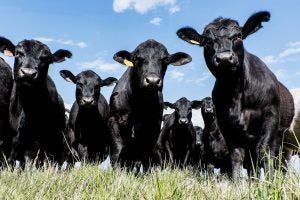Should the U.S. Department of Agriculture be in charge of regulating genetically engineered (GE) livestock and poultry, a duty now performed by the Food and Drug Administration?
This is a critical question because a multiyear modernization of federal oversight of agricultural biotechnology has been in the works. The proposed updates to the regulation of gene-edited crops and livestock strive to “exempt low-risk products of agricultural biotechnology from undue regulation.” The initiative was undertaken, but not completed during the Obama’s presidency. These needed updates were further delayed during the Trump administration, and the remaining tasks, and questions will now be passed to the incoming Biden administration.
» The USDA’s advance notice of proposed rulemaking is available here.
The agricultural biotech landscape is complex and involves three federal agencies: the FDA, the USDA, and the U.S. Environmental Protection Agency, which share authority.
In the mid-2000s, when older gene editing technology that used pathogens was common, the FDA decided to classify genetic modifications to food animals as veterinary drugs. Due to this complex web of regulatory functions, animal biotechnologies that can provide the pathways to preventing livestock diseases, adapt to climate change, and reduce greenhouse gas emissions have been delayed, even as newer and less risky GE methods were developed.

Updated regulations are urgently needed in the USA, and our international competitors will certainly be working on quickly approving the use of such helpful biotechnologies. American farmers need access to biotechnology that can help livestock resist diseases, as the risks are increasing due to climate change, antibiotic resistance and more. There is a real fear that competing countries will produce livestock at a much lower cost through biotechnology, and America will lose critical competitive edge.
British researchers have already announced plans to raise chickens with an immunity to influenza. A small genomic cut that can prevent the virus from infecting its hosts. Not only will chickens live longer healthier lives, but devastating human pandemics, such as the current coronavirus pandemic, could be prevented.
The biotechnology regulatory web
Biotech crops are overseen by the USDA, and dozens of varieties are aggressively marketed. In contrast, the FDA has approved only two GE animals for human consumption: a salmon in 2015, and a pig in 2020, the first GE animal ever intended for both medical and food use.
Under the new proposal, the FDA will retain authority over GE animals developed for nonagricultural purposes, such as medical or pharmaceutical use. (It also would continue to regulate dairy and shell eggs). But GE cattle, sheep, hog, horses, catfish, and domesticated fowl for human consumption will pass to the USDA.
- The FDA has responsibility for the safety of food and animal feed, and for the safety and efficacy of human drugs and biologics, and animal drugs. Within the FDA, there are four centers with responsibilities for biotechnology products: the Center for Food Safety and Applied Nutrition (CFSAN); the Center for Veterinary Medicine (CVM); the Center for Drug Evaluation and Research (CDER), and the Center for Biologics Evaluation and Research (CBER).
- The EPA has responsibility for the use of pesticides and setting allowable levels (tolerances) of pesticide residues in food, and for the regulation of non-pesticidal toxic substances, including microorganisms.
- The USDA has responsibility for the safety of meat, poultry and egg products; for regulating potential agricultural plant pests and noxious weeds; and for the safety and efficacy of animal biologics. Within the USDA, the Animal and Plant Health Inspection Service (APHIS) has the major responsibility for biotechnology regulation, with additional possible responsibilities for the Food Safety and Inspection Service (FSIS).
Unfounded fears?
Everyone agrees that it is essential for appropriate safety measures to remain in place and that consumers remain confident in the regulatory system.
The choice of the USDA to oversee animal GE concerns some people. The USDA allows bioengineered crop developers to self-determine whether their products qualify for exemptions from regulation. Some see this as a relinquishing oversight to biotechnology developers, while many applaud this method. Under this framework, apples and mushrooms that resist browning — created through new CRISPR gene editing — hit the market in record speed. The CRISPR gene editing simply disrupted certain genes that allow for plant tissue to brown when bruised. No new genes were added.
It is highly likely that animal geneticist could (and would) want to bring to innovations to market quickly — for example, eggs that only yield hens, dairy cattle that are all born female, beef cattle all born male, and bulls that don’t produce horns.
An additional concern is transparency in consumer food GE labelling, which has seen rancorous public debate. Current laws require labeling on bioengineered foods intended for human consumption that contain more than 5 percent GMO ingredients. But what are the quality standards to ensure these goals are met? While it is easy to detect GM ingredients in products where the GM ingredient is the main ingredient (like tofu or popcorn), it is not so easy to detect them in processed products like oils, sugars, and starches, which no longer contain any novel DNA or proteins.
The regulatory endgame
Ultimately, a comprehensive, end-to-end easy to understand, implement, and oversee policy that is based on science is desperately needed in the U.S. The American public and farmers deserve action on these policies. A food supply that is poised to meet the challenges of the future, is safe, affordable, competitive, and secure is a priority everyone can unite behind.
This is an issue that is very close to my heart. When I was an agricultural biotechnology graduate researcher at the University of Connecticut way back in the early 2000s, we performed the first study of its kind showing the meat and milk from cloned cattle was the same as from conventional breeding. How could so little have changed in the 20 years since I was a young, naïve researcher thinking we could quickly make the world a better place through biotechnology?
Dr. Carol Lynn Curchoe is the founder of ART Compass, and the author of The Thin Pink Line, Regulating Reproduction. You can find her on Facebook, Twitter, Instagram, and LinkedIn.



